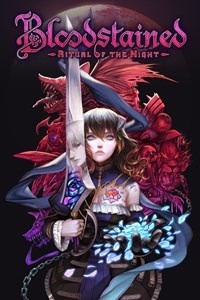Breaks Easily
I was struggling to assign a score to this game. Let me say clearly, this is a good game, but it loses a lot of points for lack of originality. In some ways , little has changed since Castlevania: Circle of the Moon (though it is an inferior title), which was released by Konami in 2001, and that game was just imitating the first ever “Igavania,” which is Castlevania: Symphony of the Night. This is an “Igavania” in the sense that Koji Igarashi was at the helm of development efforts, but scratch the “vania,” because this game doesn’t bear the Castlevania name or license. Igarashi formed a new team and crowdfunded this one on Kickstarter. It is just so similar to the last six games in the Castlevania series, those on Game Boy Advance and Nintendo DS, that this is just more of the same. If this is your first Igarashi game, maybe it’s great, but I would love to see some changes to the formula.
If you’ve never played an Igavania, let me spell it out. You traverse a massive map on a 2D plain, fighting monsters and bosses. Some regions are blocked off, accessible only after acquiring a key item or ability, such as a double-jump. You level up and slowly become more powerful, similar to an RPG. It is very similar to the Metroid series, with more of an emphasis on combat. The combat is highly refined, requiring good timing and strategy for each unique monster. That about sums it up. Castlevania: Dawn of Sorrow had an excellent “Souls” system, where you collect enemy souls, and can summon the power of that enemy at any point after that. The souls drop at random, with higher likelihood of collecting one as your in-game “Luck” levels up.
This system makes a return, but you now collect “Shards.” It’s a new name, but the same concept, with one exception: the shards are highly categorized. Some enemy shards enable that enemy to assist you on-screen at all times–so-called “Familiar Shards”–and occasionally will damage other enemies or increase HP/MP periodically. Then there are “Directional Shards,” which generally let you attack in any direction, typically with a bit of range. There are a number of categories, and one shard from each category can be equipped. This is all handled in menus, and it’s worth pointing out here that the menus are really well done. I never felt overwhelmed or confused.
The graphics are not the best. The characters, and enemies are mostly cel-shaded, but the backgrounds are not. I heard rumblings (source, Digital Foundry) that the reason this is typically done is it’s more cost-effective than cel-shading the entire game, but it makes things look inconsistent. Look at Jet Set Radio, a game running on much older hardware at half the frame rate. It’s pure eye candy, because they cel-shaded everything. On the topic of framerate, the game targets 60 frames-per-second, but there are dips below. The problem isn’t my hardware, but the game may have some slight shader compilation stutter. It’s an advanced topic, and I don’t fully understand it to be honest, but it will make your frame rate dip below the target. I suspect it is shader compilation stutter, because the engine this game was built on, Unreal Engine 4, is notorious for this problem. It would have been nice to play at unlocked frame rates.
The combat is the real highlight, but with so many shards and shard combinations, I was able to break the game early on. The “Heretical Grinder” shard is a long sword that can point in any direction, and does a slight amount of damage, rapidly, which means that the little bit of damage it does starts to stack. The sword is so long that you can stay a healthy distance away from your enemies and not get hurt. This shard enabled me to defeat almost every boss with minimal effort. It broke the game. The supposed hardest enemies in the game could be defeated by pointing my sword and holding the R2 trigger for long enough. It’s a bit like when a game gives you difficulty options (this one does) and you pick the absolute easiest, only to realize it’s now a cakewalk.
The game ended rather abruptly. I opened a boss door not thinking much of it, and it was Gebel, the main villain of Bloodstained and final boss. I defeated him on the first try. That isn’t a flex, it’s just easy. The GBA and DS Castlevania titles have notoriously difficult final bosses, and I haven’t finished some of the games because of the final boss. There is a “good” ending and a bad one, and I got the bad one. Oh well. I understand the real treasure of the Bloodstained Kickstarter (source, the Retronauts podcast Discord server) is that we got two Curse of the Moon games with retro NES style graphics that are a throwback to classic Castlevania. This is a good game. I mean that. But the formula isn’t new. There’s a sequel in the works, and that’s great, but let’s try something different in it, shall we?
